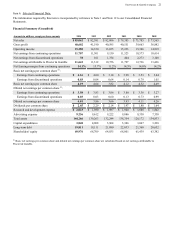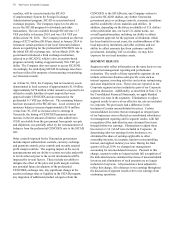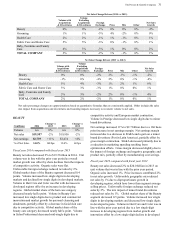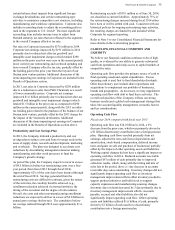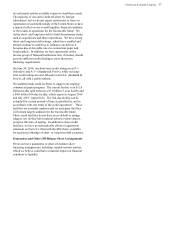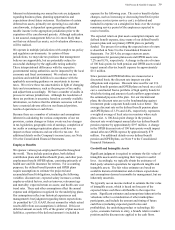Proctor and Gamble 2014 Annual Report Download - page 32
Download and view the complete annual report
Please find page 32 of the 2014 Proctor and Gamble annual report below. You can navigate through the pages in the report by either clicking on the pages listed below, or by using the keyword search tool below to find specific information within the annual report.30 The Procter & Gamble Company
royalties, will be executed under the SICAD
(Complementary System for Foreign Exchange
Administration) program. SICAD is an auction-based
exchange program. The Company expects to be able to
access the SICAD program for dividends and other
transactions. The rate available through SICAD was 11.7
VEF per dollar in January 2014, and was 10.6 VEF per
dollar at June 30, 2014. The Company incurred an after tax
charge of $275 million ($0.09 per share) in January 2014 to
remeasure certain portions of our local Venezuela balance
sheets not qualifying for the preferential CENCOEX rate to
the initial SICAD exchange rate. In late March 2014, the
government introduced a third exchange mechanism,
referred to as SICAD II, which is also an auction-based
program currently trading at approximately 50.0 VEF per
dollar. The Company does not expect to access SICAD II.
Accordingly, the underlying SICAD II exchange rates have
not been utilized for purposes of remeasuring or translating
our Venezuela results.
As of June 30, 2014, the Company had net monetary assets
denominated in local currency of approximately $1.0 billion.
Approximately $670 million of that amount is expected to be
utilized to satisfy liabilities for past imports that were
approved under CENCOEX and are measured at the
preferential 6.3 VEF per dollar rate. The remaining balance
has been measured at the SICAD rate. Local currency net
monetary balances increased approximately $110 million
versus June 30, 2013 as increases due to earnings in
Venezuela, the timing of CENCOEX payments and an
increase in the net amount of indirect value added taxes
(VAT) receivable from the government from goods receipts
and shipments, was partially offset by the remeasurement of
balances from the preferential CENCOEX rate to the SICAD
rate.
Other controls imposed by the Venezuelan government
include import authorization controls, currency exchange
and payment controls, price controls and recently enacted
profit margin controls. The ongoing impact of the recent
announcements and our ability to restore net sales and profit
to levels achieved prior to the recent devaluations will be
impacted by several factors. These include our ability to
mitigate the effect of the price and profit margin controls,
any potential future devaluation of the preferential
CENCOEX exchange rate, any significant change in the
auction exchange rates or liquidity in the SICAD program,
any migration of additional product categories from the
CENCOEX to the SICAD rates, any Company actions to
access the SICAD II market, any further Venezuelan
government price or exchange controls, economic conditions
and the availability of raw materials and utilities. In
addition, depending on the future availability of U.S. dollars
at the preferential rate, our local U.S. dollar needs, our
overall repatriation plans, including our ability to obtain
government approval for the payment of dividends, which
has been limited in recent years, the creditworthiness of the
local depository institutions and other creditors and our
ability to collect amounts due from customers and the
government, including VAT receivables, we may have
exposure for our local monetary assets.
SEGMENT RESULTS
Segment results reflect information on the same basis we use
for internal management reporting and performance
evaluation. The results of these reportable segments do not
include certain non-business unit specific costs such as
interest expense, investing activities and certain restructuring
and asset impairment costs. These costs are reported in our
Corporate segment and are included as part of our Corporate
segment discussion. Additionally, as described in Note 12 to
the Consolidated Financial Statements, we apply blended
statutory tax rates in the segments. Eliminations to adjust
segment results to arrive at our effective tax rate are included
in Corporate. We previously had a difference in the
treatment of certain unconsolidated investees. Certain
unconsolidated investees that are managed as integral parts
of our businesses were reflected as consolidated subsidiaries
for management reporting and in segment results, with full
recognition of the individual income statement line items
through before-tax earnings. Eliminations to adjust these
line items to U.S. GAAP were included in Corporate. In
determining after-tax earnings for the businesses, we
eliminated the share of earnings applicable to other
ownership interests, in a manner similar to noncontrolling
interest, and applied statutory tax rates. During the final
quarter of fiscal 2014, we changed our management
accounting for unconsolidated investees. Pursuant to this
change, segment results no longer include full recognition of
the individual income statement line items of unconsolidated
investees and eliminations of such amounts are no longer
included in Corporate. All periods have been adjusted to
reflect this change. All references to net earnings throughout
the discussion of segment results refer to net earnings from
continuing operations.



